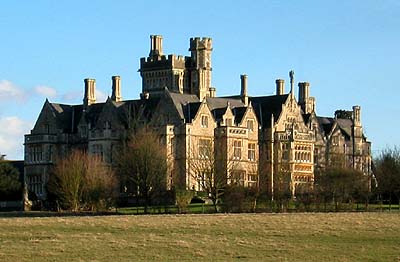
RBH Home
Maps & Travels
Articles
Legends
Towns & Villages
Castles & Houses
Churches
Biographies
Gentry
Family History
Odds & Ends
Mail David
 New Lodge
New LodgeWinkfield, Berkshire
The present building at New Lodge was built in 1857. It is arranged around a central courtyard over 3 floors. Currently used as offices, the building has been altered very little from when it was used as a private residence and hence retains well proportioned reception rooms on the ground floor, large former bedrooms on the first floor and ancillary accommodation on the second floor. There are extensive cellars currently used as storage. As well as maintaining original features such as the main carved wooden staircase surrounded by exquisite stained glass work, the property has undergone some modernization including the fitting of a passenger lift serving all floors. There is a tower with an open roof area on the 6th storey which provides excellent views over the surrounding countryside as far as Stokenchurch to the north.
The house was built on the site of a much older building of which no trace remains. From local history it can be established that this was probably a Royal Hunting Lodge when the surrounding area was part of Windsor Forest. The first house appears to have been erected by the Keeper of Cranbourne Chase, Sir Richard Weston, in 1518. Twenty years later, it was known as Hounds' Lodge, because it was situated near the Royal Kennel. By the reign of King James I (1603 - 1652), it had become a Keeper's House at the centre of New Lodge Walk, one of the several divisions of the Forest. One of the Stavertons from Warfield was the Keeper and there is an old story of the monarch himself knighting a poor tinker in the vicinity. In 1637, during the reign of Charles I, in a period of unrest before the Civil War, it is recorded that a riot took place and 100 deer were killed at New Lodge by the people. After the Restoration in 1660, a Master Keeper at New Lodge petitioned Charles II for the restitution of the place he had lost during the trouble.
King George II placed New Lodge at the disposal of his son William Augustus, Duke of Cumberland in 1751, and it was also used for a period by his Deputy as Forest Ranger of Windsor Forest. By 1791, his Equerry and Stable Manager, Major-General Studholm Hodgson was in residence and, seven years later, the house and 20 acres of land were granted by King George III to his niece, Princess Sophia, daughter of the Duke of Gloucester. The site was occupied by an Italian Villa in the first half of the 19th Century.
The first occupants of the present house were the Belgian Ambassador, Jan Silvain der Weyer and his wife Elizabeth. It was built as a wedding present by the bride's father, Joshua Bates of Weymouth, USA, on land granted to the Van der Weyers, it was believed, by Queen Victoria, who later visited them and had tea here.
The architect was T. Talbot-Bury and the building is described as Tudor-Gothic in the style of Pugin-Barry. It took three years to build and there are commemorative stones on the North-West and North-East wings laid by Joshua Bates and Elizabeth Van der Weyer. The tiles are Delft and the stained-glass windows bear quotations from Hamlet.
In the gardens, there are some very old oaks and many younger trees. The Wellingtonias along the main driver were planted mainly by Royalty, including Queen Victoria, King Edward VII and King Leopold. Elm Avenue on the West side (now destroyed) was planted by the Duke and Duchess of Teck, parents of Queen Mary. Rumour has it that New Lodge was used as a place of courtship by the Duke of Clarence and later by his brother who became King George V.
The house was sold for £12,000 in 1920 by Capt William Van der Weyer, presumably a grandson of the original owner, to Dr Venebles who, in 1925, leased it to New Lodge Clinic Ltd. The latter company sub-let to Sir Malcolm Deleringe and others for accommodation ofrefugees in 1939, but in 1942 the property was purchased by Dr. Barnardo's Homes for £24,000. In 1992 a reunion of ex-Barnardo boys who lived at New Lodge between 1950-1955 was arranged. The day was such a success it has become a bi-annual event.
In 1956, the building was purchased by the British Transport Commission for £24,000. After refurbishment, costing over £100,000, it was used as a training school for railway catering staff. Barbour Index purchased New Lodge in January 1972 and took up occupation in June of the same year after further refurbishment.
In the years since 1974, further refurbishment work has been carried out on the interior and exterior of the building and the gardens. As well as making the building a better place in which to work, the objective was to restore the property, so far as is practicable, to its original condition and decoration.
New Lodge
is currently used as offices. It was last offered for sale by Strutt &
Parker in 2004.
